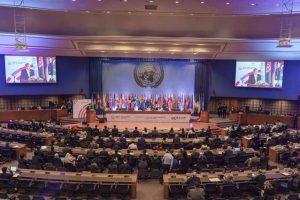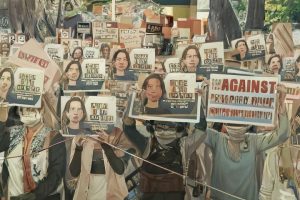Mexico’s apprehension of the world’s most-wanted drug boss yesterday struck a blow to a cartel that local and U.S. authorities say swelled into a multinational empire, fueling killings around the world.
Mexican security forces captured Joaquin “El Chapo” Guzman early yesterday in the Pacific beach town of Mazatlan after trailing him since at least Feb. 13, Attorney General Jesus Murillo Karam told reporters yesterday at the Mexico City airport. He said 13 people were apprehended in all, with no shots fired. Authorities also seized guns, a rocket launcher and 43 vehicles.
After Murillo Karam spoke, security forces paraded a mustachioed Guzman across the airport tarmac and onto a police helicopter in front of the gathered press corps. He wore a white, button-down, long-sleeve shirt and dark jeans and looked at the ground as a masked marine in camouflage fatigues held him by the scruff of the neck.
Guzman was at the center of a trafficking industry that converted swaths of Mexico into battlegrounds as competitors vied for lucrative trade routes and federal security forces attempted to restore order. The U.S. State Department had a bounty of as much as $5 million and Mexico was offering 30 million pesos ($2.26 million) for his arrest.
“This is huge,” Alejandro Hope, a former government intelligence officer and now a security analyst at the Mexican Competitiveness Institute, said in a telephone interview from Mexico City. “This is the end of the line for old-style organized crime in Mexico. It will be more decentralized with more gangs.”
‘Landmark Achievement’
Guzman is being held in a maximum-security prison near the central Mexican city of Toluca, according to the press department of the Attorney General’s Office. President Barack Obama met with Mexican President Enrique Pena Nieto and Canadian Prime Minister Stephen Harper in Toluca last week.
U.S. Attorney General Eric Holder called the arrest a “landmark achievement.”
“The criminal activity Guzman allegedly directed contributed to the death and destruction of millions of lives across the globe through drug addiction, violence, and corruption,” Holder said in a joint statement from the U.S. Justice Department and the Department of Homeland Security.
U.S. Agents
Agents with U.S. Immigration and Customs Enforcement and the Drug Enforcement Administration helped gather the intelligence that led to Guzman’s arrest, according to a senior U.S. law enforcement official who requested anonymity because he was not authorized to speak publicly about the investigation. A breakthrough came in November when U.S. authorities arrested an associate of Guzman’s organization, generating intelligence that helped pinpoint the leader’s whereabouts, the official said.
The newspaper Reforma reported that Mexican officials obtained a satellite phone number for Guzman earlier this month after making several arrests of lower-level associates. The DEA offered technological help in tracking the signal, and then accompanied Mexican agents over the ensuing days.
They detected a call from the phone as Guzman was trying to escape from Culiacan, Mexico, and the voice was confirmed as his, according to Reforma. Later in the day, the signal was again picked up in Mazatlan. Agents watched him for almost a week to assess his movements and security detail. Early yesterday, Mexican special forces entered the condominium building where he was staying and arrested his bodyguard, who led them to Guzman, the newspaper reported.
Prison Escape
Guzman gained fame in 2001 after escaping from a high-security prison and allegedly building up the Sinaloa Cartel, named after his home state and known for beheading its enemies or hanging their bodies in public places. These tactics, coupled with his business acumen, helped him build a personal fortune of about $1 billion, according to Forbes magazine.
The press office of Mexico’s Foreign Relations Ministry declined to comment on whether the U.S. is seeking Guzman’s extradition.
U.S. Representative Michael McCaul, a Texas Republican who heads the House Committee on Homeland Security, said today that he wants Guzman extradited to the U.S., partly to ensure that “what happened in 2001 does not happen again.”
In the U.S., “we could deal with him in a secure, safe way and bring him to justice,” McCaul said on ABC’s “This Week” program.
Eduardo Medina Mora, the Mexican ambassador to the U.S., told the New York Times that the issue of extradition had not been worked out. “I think it’s important that first he faces the charges against him in Mexico,” the ambassador told the newspaper.
Natural Successor
Guillermo Valdes, who headed the nation’s intelligence agency under Calderon, said Ismael “El Mayo” Zambada, a top leader of the Sinaloa Cartel, is the natural successor to Guzman. Mexico had detained 10 of Zambada’s men, including his head of security, less than a week before Guzman’s capture.
“El Mayo has been leading the Sinaloa Cartel alongside El Chapo for 25 years,” Valdes said in a phone interview. “He’s very intelligent.”
Before his capture, Guzman had been moving among a series of properties connected by a network of tunnels through the sewers, according to Murillo Karam. In a recent attempt to detain him, authorities tried to knock down a door reinforced with steel. By the time officials broke through, Guzman had escaped through a tunnel, according to the prosecutor.
Mexican TV station Foro TV broadcast images of the spacious beachside condo where authorities said they found Guzman, saying it was 500 meters from a local police station. The footage showed drawn venetian blinds and clothes strewn about the beds and white chairs and tables.
Gang Wars
In their hunt for Guzman, federal forces refrained on several occasions from capturing him in public places to prevent civilian injuries, Murillo said, adding that no one was wounded during his arrest.
Since the 1990s, the Sinaloa Cartel has fought with almost all Mexico’s major drug cartels, including a gang founded by former elite soldiers known as the Zetas.
Guzman, who is in his 50s, overcame a poor, rural upbringing with limited education to become what the U.S. Treasury labeled in January 2012 as the “the world’s most powerful drug trafficker.”
The Sinaloa Cartel smuggles cocaine, marijuana, methamphetamines and heroin, said Jeffrey Scott, a special agent for the Drug Enforcement Agency in Washington. It operates in the U.S. and is thought to have presence in Guatemala, Honduras, Nicaragua and Peru, he said.
‘Personal Playground’
Guzman entered the drug trade in the 1980s and rose to direct the local cartel’s operations, according to Malcolm Beith, author of “The Last Narco: Inside the Hunt for El Chapo, the World’s Most Wanted Drug Lord.” Guzman’s rise was interrupted in 1993 when he was arrested in Guatemala and extradited to Mexico.
At Puente Grande prison in Jalisco state, Guzman bought off guards and inmates with funds provided by the cartel, according to Beith.
“Puente Grande became Chapo’s personal playground,” Beith wrote. Guzman and his allies were able to wander throughout the compound, throw parties and enjoy “smuggled alcohol, cocaine and marijuana, not to mention conjugal visits by women other than wives and girlfriends,” Beith said.
After Guzman’s escape, he returned to the Sinaloa Cartel, taking advantage of then-President Vicente Fox’s offensive on rival gangs.
‘Massive Consequences’
The Department of Justice indicted Guzman in absentia in Chicago in August 2009, charging him with conspiring to transport drugs across international borders. The Chicago Crime Commission, a public-safety group, named Guzman the city’s public enemy No. 1 last year, after the DEA blamed his cartel for fueling the city’s violence by supplying most of its narcotics. Chicago had the highest per capita murder rate among the four most populous U.S. cities in 2012. Guzman was also indicted in the Western District of Texas in 2012.
Guzman’s arrest may trigger more violence in Mexico, especially in areas where pacts struck between his cartel and local drug gangs helped bring down murder rates, such as the border city of Ciudad Juarez, said Ioan Grillo, author of the 2011 book “El Narco: Inside Mexico’s Criminal Insurgency.”
“This is going to have massive consequences in the trafficking trade,” Grillo said in a phone interview in New Haven, Connecticut. “In recent years in Mexico, when major drug capos have been taken down, we’ve seen a clear pattern in short-and medium-term explosions of violence where their underlings are fighting for positions.”





